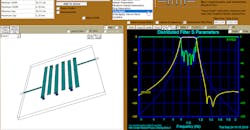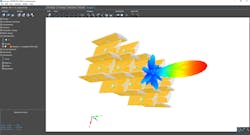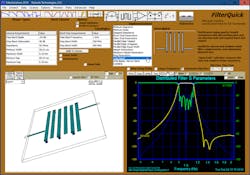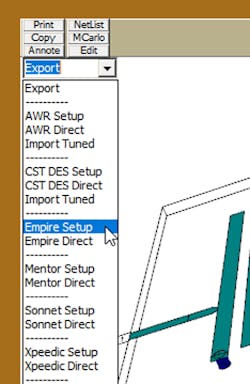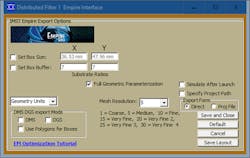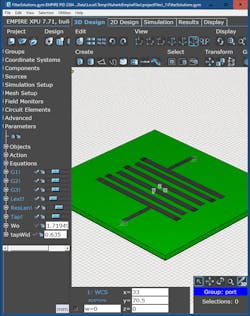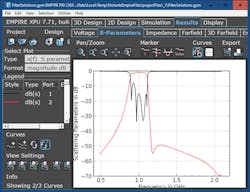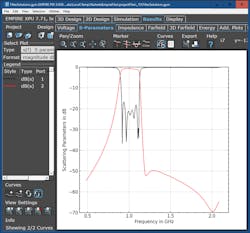Antenna 3D Simulator and Optimizer Handles Planar Filter Designs, Too
Download this article in PDF format.
For many years, IMST has been in the business of producing expert 3D electromagnetic (EM) simulation software. With its Empire XPU product, IMST emphasizes and focuses on antenna design and optimization. Nuhertz Technologies has also been around for many years, producing expert filter design software. And with its FilterSolutions tool, the company focuses on accurate 3D planar design and optimization.
Therefore, it seems a natural fit for these two products to work together so that users can take advantage of the best features of both. Specifically, IMST’s Empire XPU EM optimization process can be used on planar designs created with Nuhertz’s FilterSolutions.
Empire XPU Antenna Design Overview
Empire XPU is an advanced 3D EM field solver based on finite-difference time domain (FDTD) that’s been highly optimized for memory efficiency and performance speeds. It uniquely features an innovative software acceleration that makes it possible to use the complete RAM, achieving performance of up to 22 GCells/s on a dual CPU workstation.
Empire XPU supports a broad range of applications (i.e., RF passive components and circuits, packages, waveguides, and EMC), but its major focus is antennas of all varieties. The geometry and excitation are rapidly set up in a sophisticated graphical user interface (GUI). Expert-level automatic meshing and optimization algorithms guide the user to the final design. Visualization features help the user obtain physical insight into the EM wave phenomena.
FilterSolutions Planar Design Overview
The FilterSolutions planar design module rapidly produces circuit-level-optimized planar designs that account for internal lossy and discontinuous parasitic effects. The FilterQuick beginner’s design panel is easy to use and understand, providing visual aids to help new users get started. For experienced users, an advanced panel delivers full design power in an easy-to-access compact panel.
Planar designs may be exported directly into Empire XPU, including the stackup, layout, and full parameterization needed to tune and optimize all of the relevant layout geometries. The exported design is fully equation-based so that the individual parameters update the entire layout geometry as needed to keep the design coherent.
Empire Setup for Antenna 3D Simulation
Antenna simulations require the absorption of boundary conditions and space for the reactive near field. Empire XPU automatically creates a suitable environment, depending on the desired frequency range. The model is excited at ports by a time pulse that covers the entire frequency range. S-parameters are obtained after energy has decayed. Monitors record the desired field values for the quantification of typical antenna parameters, such as gain, beam width, or side-lobe levels. Antenna arrays can be excited simultaneously with amplitude taper and broadband phase shift (Fig. 1) or sequentially to obtain coupling parameters.
1. This Empire XPU simulation of a Vivaldi antenna array shows the radiation pattern at 12 GHz.
Empire Setup for Antenna 3D Optimization
Initial antenna designs are available as built-in templates or can be imported from other CAD sources. It’s also possible to create the structure from scratch or with the aid of scripting. The geometry and material properties can be defined as variables and different optimization algorithms can be applied to find the best parameter set. Different result sources and goal functions may be applied in the error function, which the software then tries to minimize. Because the optimization requires running many variable combinations, Empire XPU can use job distribution and parallel execution on remote servers during the process.
Empire Scripting Overview
With the aid of the Python programming language, the model is able to be set up partially or completely with the aid of scripting. Even parametric models, equations, and optimization goals can be defined by scripts to be used in a subsequent optimization process. It’s also possible to run simulations completely in the background on the local computer or remote machines. Furthermore, scripting can be used for post-processing derived results to be applied in the optimization goal functions.
FilterSolutions Planar Design Capabilities
FilterSolutions produces a great deal of topologies for planar designs with easy to-access form entries for design requirements. The FilterQuick design panel tabulates the topology options in an easy-to-use selection format, along with a sample pictorial graphic and textual feedback, so that new users will know exactly what they are selecting.
Designs may be optionally optimized for circuits-simulation response by selecting “Quick Optimize.” The circuits simulation accounts for lossy and discontinuous parasitic effects. The filter topology display may be selected to be a schematic with geometric dimensions, a planar layout view, or a 3D view. Figure 2 shows a simple interdigital design with default requirements entries, a 3D layout, and S-parameter circuits-simulated results.
2. A simple interdigital design is depicted in this FilterQuick design panel.
FilterSolutions Direct Exportation into Empire
The “Export” dropdown on the upper left is used to export to Empire XPU (Fig. 3). Selecting “Setup” will bring up the Empire export panel, while selecting “Direct” will export directly to Empire using previously saved export entries. The Empire export page provides all of the export options available to Empire XPU, including, but not limited to, path, substrate geometry, DMS and DGS defected selections, and simulation speed/accuracy selections.
3. The FilterSolutions Export drop down selection is shown (top) along with the Export page (bottom).
Empire Simulation and Optimization of FilterSolutions Planar Designs
The FilterSolutions design export into Empire XPU includes all parameters and equations needed for Empire to apply its 3D EM optimizations capability directly on the exported FilterSolutions planar design. Easy-to-use slider bars may tune any of the exported parameters. All equations needed to maintain the integrity of the planar design, as well as the tunable parameters, are included in the exported design. Figure 4 shows the Empire XPU GUI with the exported interdigital filter.
4. This interdigital design was exported from FilterSolutions into Empire XPU.
3D simulations can be initiated directly on the exported project by selecting “Start Simulations” from the File menu drop down. Figure 5 shows the 3D EM S-parameter results in the Empire simulation page. It’s clear that some EM optimization is desirable for this filter design.
5. These interdigital Empire XPU 3D simulation S-parameter results reveal that some filter optimization is needed.
3D EM optimization may be applied with the Simulation Optimization Control. Optimization goals are already installed in the project, and simply need to be included in the Simulation Optimization goals page. A tutorial in the FilterSolutions Empire Export page provides detailed Empire GUI instructions for the optimization process.
Once the optimization process is configured, users only need to start it and then just sit back and let Empire XPU do the optimization work. After the optimization is complete, the optimized parameters can be copied back into FilterSolutions. Figure 6 shows the fully optimized Empire XPU 3D EM S-parameter trace.
6. Shown are the fully optimized Empire XPU 3D EM S-parameter traces.
Conclusion
This article reveals that even though the raw synthesis of antenna and filter design are dramatically different tasks that require widely differing design skills and tools, finalization of the design process is similar enough whereby the same tools can be used. Planar filters and antennas both reside in 3D space, and the fine-tuning of the geometries within that 3D space may optimize planar filters or antennas. This, in turn, brings to bear Empire XPU’s diversity as an EM optimization tool—it can efficiently perform 3D optimizations of planar filter designs as well as 3D antenna designs.
Anyone involved with planar filter design should consider synthesizing their designs with Nuhertz FilterSolutions followed by an easy-to-use direct interface to Empire XPU to finalize the 3D optimization. And, as stated, Empire XPU is a tool that extends beyond planar filters, with the ability to perform 3D EM optimizations of antennas as well.
Jeff Kahler is Technical Director at Nuhertz Technologies and Andreas Wien is Empire Product Manager at IMST.
